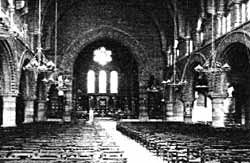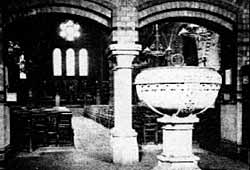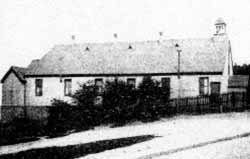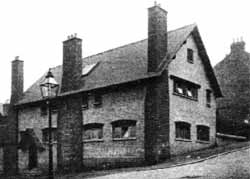Articles from the Thoroton Society Newsletter
Emmanuel - a lost church of Nottingham
By Terry Fry

It is a sad fact that too many of Nottingham’s churches have come and gone. Emmanuel, on Woodborough Road, was one of them. In spite of it being the only Anglican church designed by Watson Fothergill, the great Nottingham architect, it was demolished in the early 1970’s. Admittedly the numbers at services were down to single fgures but it is a pity that another use wasn’t found for the building. Thus the civic authorities allowed Fothergill’s only church to be demolished, along with his own house on Mapperley Road and the Black Boy Hotel on Long Row, still sadly missed by many. (Fothergill’s Baptist Chapel on Woodborough Road is still in use but as the Pakistan Centre).
The church and parish of Emmanuel have their origin in a Mission of St. Andrew in Bullivant Street, originally built for the Methodists. However, St. Anne’s should be seen as the mother church. The growing population of the St. Anne’s area put enormous pressure on the vicar who was exhausted by the work load. So funds were raised by the Nottingham Spiritual Aid Society to erect an iron church on Woodborough Road in 1880, at a cost of £760. Originally it was intended to purchase the corner site of Woodborough Road and Northville Street, but the Roman Catholics slipped in and outbid them for the land - on which they built St. Augustine’s. However, land was bought next door and the iron church was put up there.
The first curate was Rev. E. Holroyde who, appropriately, was a graduate of Emmanuel College, Cambridge. Rev. Henry Wright, one of the founders, drowned in Coniston Lake shortly after preaching the sermon at the dedication. The frst vicar was Rev. F. W. Paul who remembered many rough and profane people went to the iron church. But he had the devoted services of John Ozenbrook as verger and caretaker for 17 years. He was a pensioner trooper of the 9th Lancers, a veteran of the Crimean War and the Indian Mutiny. The iron church was sold in 1885 to become the first St. Bartholomew’s on Blue Bell Hill, then later their church hall.
From 1886-93 part of a workshop on Northville Street was used as a parish room for meetings such as the Band of Hope and men’s Institute, but, above all, where they gave breakfasts to hundreds of poor children in hard winters. It was replaced by an iron Parish Room on the site of the old iron church in 1892. In October 1908 a new Mission Room and Men’s Institute was opened in the north-east corner of the parish.
The district of Emmanuel had become a parish in 1886. The impetus for a new church in this poor area came from St. Andrew’s and its vicar, Canon Tebbutt. He and others founded the Nottingham Church Extension Society on January 9th 1877. It bought the ground on which Emmanuel was built in the early 1880’s. In 1880 the Society accepted an offer of £2,000 for the building fund from Miss Hyndman’s Trustees, an Evangelical Trust. In return the Trustees were to appoint all the subsequent vicars.
The application for the new church was made to the Incorporated Church Building Society in April 1883. It stated that the area was entirely populated by the poorer classes and no persons of large means lived in the locality. Thus it was diffcult to raise funds. The estimated cost was £5,800. By November the vicar of St. Ann’s advised that, due to lack of funds Emmanuel’s church chancel be postponed,


The architect chosen was Fothergill Watson, who changed his name to Watson Fothergill in 1892. He submitted his design to the Incorporated Church Building Society in April 1883. The style was Gothic, cruciform, to stand north and south following the line of Woodborough Road. Built of Bulwell stone and Bath stone dressings, it was to have nave, chancel, aisles, transept, bell gable and vestry - but the I.C.B.S. rejected it for several reasons. Watson was miffed, as the design had been selected in competition three years previously. However, he made changes, e.g. increasing the chancel arch pillars to 2ft. 4 ins. and making the walls above arcades solid, so the design became acceptable.
Unfortunately funds were not available for a chancel, so the foundation stone was laid on January 17th 1884 for a limited building. The nave was consecrated on January 27th 1885.
The east end of the church was not finished until March 1893 when the new chancel and organ chamber were consecrated. An old organ from the late 18th century was in use up to November 1903 when a new one built by Musson and Compton of Nottingham was installed. The baptistry and clergy and the choir vestries were added in 1901. Red and blue bricks were used in patterns to correspond with the rest of the interior. A dado was carried throughout the aisles and transepts, consisting of heads of apostles in glass mosaic. Pevsner said that the interior was of a very ambitious and busy design, with lots of patterned brick and a curious tri-partite chancel arch.

Emmanuel - the iron church

Emmanuel - Mission Room and Men’s Institute
The work involved in building the new chancel was the responsibility of Rev. Llewellyn Gwynne who was the vicar from 1892-99. He was an extraordinary man who rose to fame as Bishop of Sudan and Deputy Chaplain General of the British Army in the First World War. He returned to the parish in 1908, as Archdeacon Gwynne, to open the new Mission Room and Men’s Institute, and again in 1929 to unveil the new windows in memory of J. Potter Briscoe, the Principal Librarian of Nottingham, who had been a churchwarden of Emmanuel for many years.
When Rev. W. E. Ives took his frst service on January 28th 1900 he was greeted by a congregation of 750. By 1970 there were only six or seven elderly members on Sunday evenings, plus a choir of thirty youngsters, often in a cold and gloomy building. Its closure had been mooted in the 1960’s and an Inspector from the Ministry of Housing submitted his report at an inquiry in July 1969. He claimed that the church was impossible to heat, the roof tiles were deteriorating badly and it was impracticable to modernise because the chancel was so far above the nave. The church is typical of its period but has no great architectural merit, wrote the Inspector. With such a dismissive comment its fate was sealed.
The last service in Emmanuel took place on May 21st 1972. It was in future to be amalgamated with the new St. Ann’s. On July 13th The Guardian Journal reported on the demolition of The Church on the Hill. From its completion in 1901 it had lasted just 71 years.
< Previous